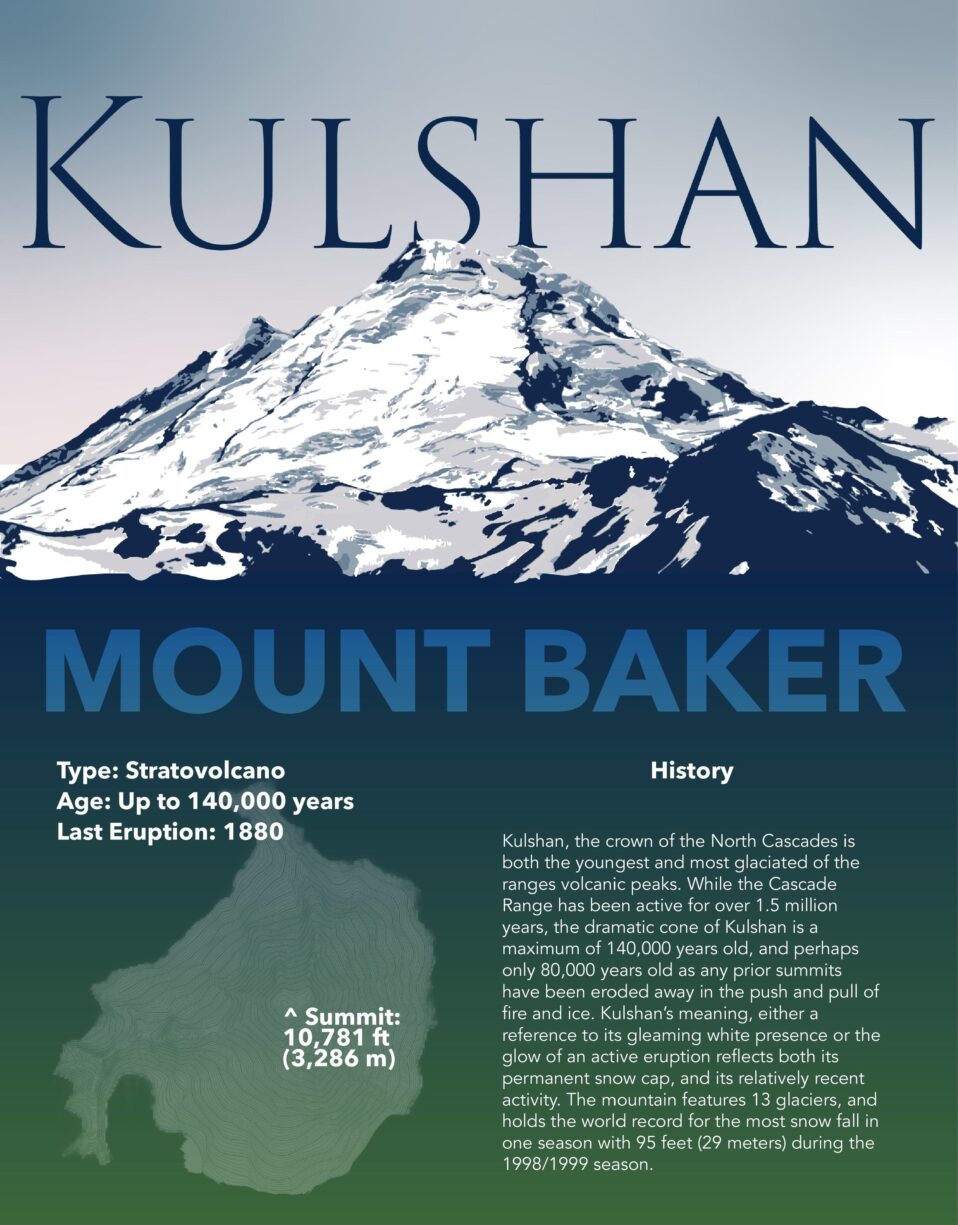Your cart is currently empty!
Native Names – Kulshan (Mt. Baker)

One of my favorite historical images to imagine is that of Spanish Colonizers sailing into the Salish Sea, being confronted by the power and majesty of the Cascade Range volcanoes. In June of 1792, as the youngest of the great peaks, Kulshan was erupting during the arrival of those Spanish ships. Dionisio Alcalá Galiano and Cayetano Valdés noted;
“During the night [while anchored in Bellingham Bay] we constantly saw light to the south and east of the mountain of Carmelo [Baker] and even at times some bursts of flame, signs which left no doubt that there are volcanoes with strong eruptions in those mountains.”
Well into the 19th century as more Europeans arrived, Kulshan continued her fury. As recently as the 1880’s, reports of whole forests on fire, huge lahars and ash clogged rivers plagued the area. Thunder and lightning accompanied the great explosions. To the settlers, this must have seemed terrifyingly foreign. To the Lummi Nation who had lived in concert with the great mountain for millennia, there was an explanation.
“You see, it hardly ever thunders here; but yonder in the mountains it quite often thunders. The thunder is caused by a great bird. You have seen the fish hawk catch a fish. Well, the thunderbird is many hundreds of times larger than a fish hawk. It is so large that it can carry a large whale in its talons from the ocean to its nest. The feathers of its wing tips are as long as a canoe paddle. This huge bird has its home yonder on Mt. Baker, where you see the clouds piling up now. Whenever this bird comes from its nest and flies about the mountain top it thunders and lightnings, and even when it is disturbed in its nest it makes the thunder noise by its moving about even there.”
This recognition of the peak of Kulshan being the home of the Thunderbird coincides with the meaning of the title Kulshan itself, referring concurrently to something struck by thunder and burning, as the caldera of an active volcano is, or meaning a great white peak, as the volcano is when dormant.
Theodore Winthrop was the first settler to record the name of the mountain while he traveled from Victoria on a visit to the Lummi people on August 14th and 15th, 1853. His encounter with the Lummi prompted a rather impassioned argument for the use of the native name Kulshan, a perspective that resonates still today.
“Kulshan, misnamed Mount Baker by the vulgar, is their northernmost buttress, up at 49° and Fraser River. Kulshan is an irregular, massive, mound-shaped peak, worthy to stand a white emblem of perpetual peace between us and our brother Britons. The northern regions of Whulge [Puget Sound] and Vancouver Island have Kulshan upon their horizon. They saw it blaze the winter before this journey of mine; for there is fire beneath the Cascades, red war suppressed where the peaks, symbols of truce, stand in resplendent quiet. Kulshan is best seen, as I saw it one afternoon of that same August, from an upland of Vancouver Island, across the golden waves of a wheat-field, across the glimmering waters of the Georgian Sound, and far above its belt of misty gray pine-ridges. The snow-line here is at five thousand feet, and Kulshan has as much height in snow as in forest and vegetation. Its name I got from the Lummi tribe at its base, after I had dipped in their pot at a boiled-salmon feast. As to Baker, that name should be forgotten. Mountains should not be insulted by being named after undistinguished bipeds, nor by the prefix of Mt. Mt. Chimborazo, or Mt. Dhawalaghiri, seems as feeble as Mr. Julius Caesar, or Signor Dante.”
Like the other peaks discussed in this series, Kulshan has various names from the native peoples who inhabited the Salish coast. They include;
-
Quck Sam-ik (Nooksack: kw’eq sámit, “white mountain”)
-
Kobah (Skagit: qwúbə’, “white sentinel”
-
Tukullum or Nahcullum (in the language of the unidentified “Koma tribe”).
